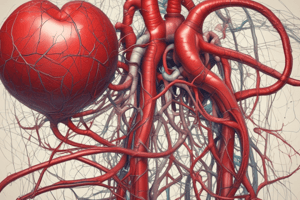Podcast
Questions and Answers
What does the inferior vena cava empty into?
What does the inferior vena cava empty into?
- Right atrium (correct)
- Left ventricle
- Left atrium
- Right ventricle
Where is the tricuspid valve located?
Where is the tricuspid valve located?
Between the right atrium and right ventricle
What is the function of the tricuspid valve?
What is the function of the tricuspid valve?
Prevents backflow of blood
During pulmonary circulation, blood leaves the?
During pulmonary circulation, blood leaves the?
What does the pulmonary artery transport?
What does the pulmonary artery transport?
What does the pulmonary vein transport?
What does the pulmonary vein transport?
During systemic circulation, blood leaves the?
During systemic circulation, blood leaves the?
When the mitral (bicuspid) valve closes, it prevents blood flow from the?
When the mitral (bicuspid) valve closes, it prevents blood flow from the?
What is the correct sequence of blood flow?
What is the correct sequence of blood flow?
The atria receive blood returning to the heart.
The atria receive blood returning to the heart.
The left side of the heart pumps the same volume of blood as the right.
The left side of the heart pumps the same volume of blood as the right.
The mitral valve has chordae tendineae but the tricuspid valve does not.
The mitral valve has chordae tendineae but the tricuspid valve does not.
The chordae tendineae prevent the AV valves from opening in the wrong direction.
The chordae tendineae prevent the AV valves from opening in the wrong direction.
A good example of an elastic artery is the?
A good example of an elastic artery is the?
What is the function of capillary walls?
What is the function of capillary walls?
Veins have the smallest lumen of all blood vessels.
Veins have the smallest lumen of all blood vessels.
The outermost layer of a blood vessel is the tunica intima.
The outermost layer of a blood vessel is the tunica intima.
The thick-walled arteries close to the heart are called muscular arteries.
The thick-walled arteries close to the heart are called muscular arteries.
Flashcards are hidden until you start studying
Study Notes
Cardiovascular System Overview
- The inferior vena cava delivers deoxygenated blood from lower body regions to the right atrium.
- Deoxygenated blood from the inferior vena cava includes contributions from the legs, abdomen, and pelvis.
- The superior vena cava also empties into the right atrium, bringing blood from the upper body.
Heart Valves and Blood Flow
- The tricuspid valve is located between the right atrium and right ventricle, preventing backflow of blood.
- During pulmonary circulation, blood flows from the right ventricle to the lungs through the pulmonary artery.
- The pulmonary artery carries deoxygenated blood, contrary to the common belief that all arteries carry oxygen-rich blood.
- The pulmonary vein transports oxygen-rich blood from the lungs to the left atrium.
Systemic Circulation
- In systemic circulation, blood exits the left ventricle and travels directly into the aorta, the body's largest artery.
- The aorta branches into smaller arteries and subsequently to capillaries, facilitating nutrient and gas exchange.
Blood Flow Sequence
- The correct sequence of blood flow is: right atrium → right ventricle → lungs → left atrium → left ventricle → aorta.
- Deoxygenated blood returns to the heart through the superior and inferior vena cava, entering the right atrium.
Heart Functionality
- Atria are responsible for receiving returning blood - this is confirmed as true.
- Both the left and right sides of the heart pump an equal volume of blood, confirmed as true.
Structure of Valves
- Both the mitral (bicuspid) valve and the tricuspid valve are supported by chordae tendineae, which prevent improper valve opening.
- Chordae tendineae anchor the papillary muscles to the valves, ensuring they close properly during ventricular contraction.
Arteries and Veins
- The aorta serves as a prime example of an elastic artery, characterized by a significant presence of collagen and elastin in its walls.
- Elastic arteries allow for stretching with each heartbeat, helping to maintain blood pressure.
Capillaries and Blood Vessel Structure
- Capillary walls are specifically designed for efficient material exchange between blood and tissues.
- The assertion that veins have the smallest lumen of all blood vessels is false; they actually have larger lumens compared to arteries.
- The tunica intima is the innermost layer of blood vessels, contrary to the claim that it is the outermost layer.
Additional Notes
- Muscular arteries are not characterized solely by thickness; they differ from elastic arteries in their role and function.
Studying That Suits You
Use AI to generate personalized quizzes and flashcards to suit your learning preferences.




